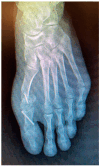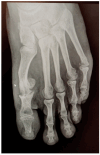Implementation of an Electrosurgical Checklist in a Podiatry Unit in Relation to a Case of Inadvertent Burns during Hallux Valgus Surgery
- PMID: 40729211
- PMCID: PMC12225462
- DOI: 10.3390/reports6030043
Implementation of an Electrosurgical Checklist in a Podiatry Unit in Relation to a Case of Inadvertent Burns during Hallux Valgus Surgery
Abstract
Iatrogenic burns are unpleasant and sometimes difficult to explain to patients. Podiatric surgeons routinely use electrosurgical devices to cut and coagulate tissue during surgical procedures. Although advances in technology have made electrosurgery increasingly safer for patients and personnel, its use is still poorly understood by the surgical community, and the hazards associated with its use still exist presently. Human error, direct or indirect transfer of electricity to a conductive device, or device malfunction can cause serious adverse events, including burns, electrical shocks, and or fires. Here, we report a rare case of a 43-year-old man who suffered severe burns during hallux valgus surgery. The surgeon and the nursing staff did not notice any injuries during the surgical intervention. This unusual clinical case serves to highlight the importance of implementing protocols to prevent injuries related to the use of electrosurgery. Based on this report, a specific checklist was implemented to prevent adverse events related to electrosurgery in our podiatric surgery unit to reduce the risk of electrosurgical complications. The implementation of the checklist can be useful to help health professionals improve patient safety during surgery and avoid potential medico-legal liability claims.
Keywords: burns; electrosurgical injury; electrosurgical safety; monopolar diathermy.
Conflict of interest statement
The authors declare no conflict of interest.
Figures






Similar articles
-
Does Minimally Invasive Surgery Provide Better Clinical or Radiographic Outcomes Than Open Surgery in the Treatment of Hallux Valgus Deformity? A Systematic Review and Meta-analysis.Clin Orthop Relat Res. 2023 Jun 1;481(6):1143-1155. doi: 10.1097/CORR.0000000000002471. Epub 2022 Nov 4. Clin Orthop Relat Res. 2023. PMID: 36332131 Free PMC article.
-
Sexual Harassment and Prevention Training.2024 Mar 29. In: StatPearls [Internet]. Treasure Island (FL): StatPearls Publishing; 2025 Jan–. 2024 Mar 29. In: StatPearls [Internet]. Treasure Island (FL): StatPearls Publishing; 2025 Jan–. PMID: 36508513 Free Books & Documents.
-
Active body surface warming systems for preventing complications caused by inadvertent perioperative hypothermia in adults.Cochrane Database Syst Rev. 2016 Apr 21;4(4):CD009016. doi: 10.1002/14651858.CD009016.pub2. Cochrane Database Syst Rev. 2016. PMID: 27098439 Free PMC article.
-
The measurement and monitoring of surgical adverse events.Health Technol Assess. 2001;5(22):1-194. doi: 10.3310/hta5220. Health Technol Assess. 2001. PMID: 11532239
-
Preexisting Diabetes and Pregnancy: An Endocrine Society and European Society of Endocrinology Joint Clinical Practice Guideline.Eur J Endocrinol. 2025 Jun 30;193(1):G1-G48. doi: 10.1093/ejendo/lvaf116. Eur J Endocrinol. 2025. PMID: 40652450
References
-
- Overbey D.M., Townsend N.T., Chapman B.C., Bennett D.T., Foley L.S., Rau AS: Yi J.A., Jones E.L., Stiegmann G.V., Robinson T.N. Surgical Energy-Based Device Injuries and Fatalities Reported to the Food and Drug Administration. J. Am. Coll. Surg. 2015;221:197–205. doi: 10.1016/j.jamcollsurg.2015.03.031. - DOI - PubMed
-
- Tucker R.D. Laparoscopic electrosurgical injuries: Survey results and their implications. Surg. Laparosc. Endosc. 1995;5:311–317. - PubMed
Publication types
LinkOut - more resources
Full Text Sources
